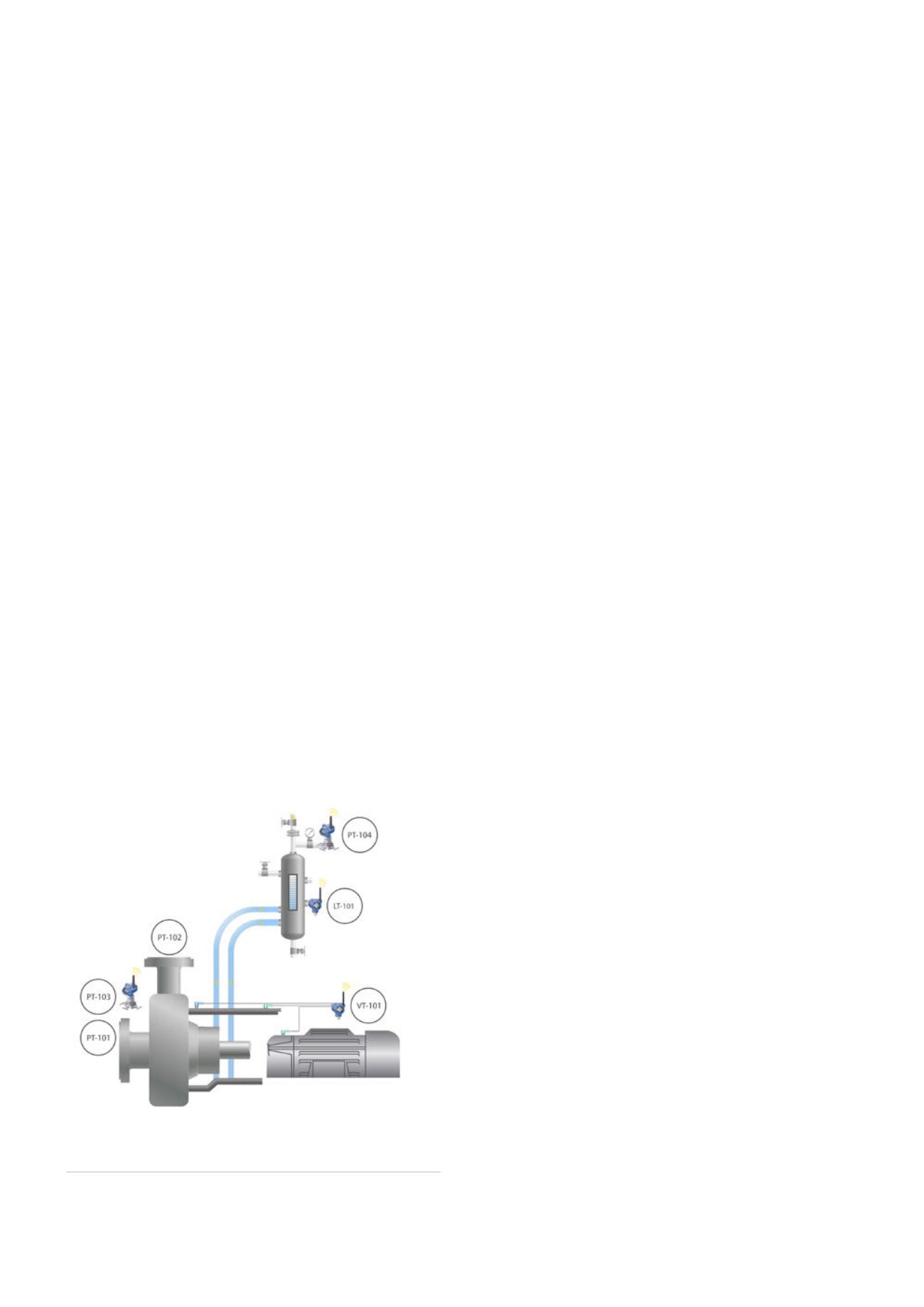
This article will first examine the role of pump monitoring
sensors and systems in liquid hydrocarbon pipelines, and then
will touch upon measurement technologies, which work hand in
hand with control systems to manage liquid hydrocarbon flows in
pipelines.
Pump monitoring measurements
Pumps in pipeline systems are monitored with a wide variety of
sensor types, some of which are depicted in Figure 2 as wireless
sensors. Main monitoring points include:
)
)
Pressure at pump intake, PT-101 – ensures the pump has
appropriate pressure. If there is not enough intake pressure,
the pump can run dry, a particular hazard for centrifugal
pumps.
)
)
Level at pump intake – detects when the liquid level drops,
can be used to protect against dry running.
)
)
Pressure at pump discharge, PT-102 – used to infer the pump’s
level of output, and to ensure the pump is operating.
)
)
Flow at pump discharge – indicates proper pump operation,
and can be used to close the loop for pump control, as
explained more fully later in this article.
)
)
Differential pressure between pump intake and discharge,
PT-103 – detects cavitation.
)
)
Pump motor temperature – indicates when a pump motor is
running hot.
)
)
Pump bearing temperature – indicates when a bearing is
exceeding safe temperature.
)
)
Pump vibration, VT-101 – this measurement is a good
indication of pump health, particularly when tracked over
time and compared to a baseline. Increases in vibration
indicate conditions such as bearing wear or pump imbalance,
which can lead to failures.
)
)
Pump seal system reservoir level (LT-101) – indicates buffer
fluid level, recommended by API-682 instead of level switch.
)
)
Pump seal system vapour vent pressure (PT-104) – indicates
high pressure, normally a result of process liquids leaking into
the buffer system and flashing to the vapour phase in the
seal reservoir. Recommended by API-682 instead of pressure
switch.
As noted above, pump seal systems often require level and
pressure measurements. API Standard 682 Fourth Edition describes
changes in instrumentation used to monitor pump seal systems.
This new edition now indicates a preference for continuous
measurements using level and pressure transmitters versus the
prior practice of using simple on-off switches.
In some applications, a pump may have a filter or a strainer.
Installing a differential pressure sensor across the filter/
strainer will indicate when maintenance is required. Instead of
just manually checking pressure periodically, this signal can be
monitored to show when the filter/strainer should be flushed
or cleaned out, which will reduce excess strain on the pump by
removing the flow restriction.
On larger pumps, there may be a lube system. If this is a
pressurised lube system, a transmitter can be installed to ensure
proper lube pressure is maintained. This is important so that
process fluids in the pipeline do not contaminate the lube system.
Lube level is another important measurement, and can be made
with a level switch or transmitter.
Wireless sensors save
Wireless sensors are increasingly used in pump monitoring systems
because they are easier to install, simpler to maintain, and much
less costly to connect to control systems.
With traditional wired instruments, it’s necessary to run either
signal wiring for a loop-powered 2-wire instrument, or power and
signal wiring for a 4-wire instrument. This new wiring is very costly
to install, and many existing wiring drawings need to be updated.
The signal wiring needs to be connected back to the control
system, which can be very expensive, particularly if no spare I/O
points are available.
By utilising wireless technologies, measurement points
can be quickly deployed. No signal wiring is needed because
measurement information is transmitted via a wireless mesh
network, and no power wiring is needed because each wireless
sensor includes its own power module.
Wireless sensors have advantages, but wired sensors are often
used instead, particularly in real time control applications, and in
pump installations with easy access to wiring infrastructure such
as cable trays and wiring cabinets.
Benefits of pump monitoring
Outputs from these wired or wireless sensors are connected to
control systems, either at the pump station or in a central control
room. The sensors and control systems combine to provide a
number of benefits:
)
)
Reduces maintenance costs.
)
)
Enables proactive maintenance.
Figure 2.
Pump monitoring diagram. A wide variety of
parameters are typically measured on pumps used in pipelines,
some of which are depicted in this diagram.
76
World Pipelines
/
FEBRUARY 2016


